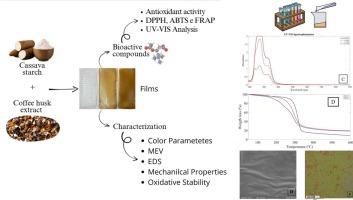咖啡壳萃取物在木薯淀粉基可生物降解包装中的价值与应用
IF 8
1区 农林科学
Q1 FOOD SCIENCE & TECHNOLOGY
引用次数: 0
摘要
对具有功能特性的可持续包装的需求日益增长,鼓励了含有生物活性化合物的聚合物薄膜的发展和农业工业残留物的增值。在这项研究中,生产了活性木薯淀粉基薄膜(FC -不含提取物),并与含有浓度为0.5% (F5)和0.75% (F75)的咖啡壳提取物的薄膜进行了比较。这项工作的目的是评估这些化合物对聚合物基体的物理、热、机械、光学和功能特性的影响。扫描电子显微镜(SEM)图像显示了均匀的表面,具有良好的萃取物分散性,并通过能量色散x射线光谱(EDS)证实了元素组成。热重(TGA)和差示扫描量热(DSC)分析表明其稳定性较高,降解温度超过300℃。力学性能方面,抗拉强度由10.31 MPa (FC)提高到66.06 MPa (F75)。含提取物薄膜的断裂伸长率也显著增加,从0.27% (FC)(刚性材料的特征)上升到2.67% (F5)和3.28% (F75),表明有塑化作用。对照膜在UV-Vis范围内的吸收较低,而提取物的掺入显著增加了吸收,提高了紫外线阻隔能力。富提取物膜的F75值分别为15.9%(2,2-二苯二酚-1-吡啶-噻嗪- DPPH)、44.3%(2,2 ' -氮基-双(3-乙基苯并噻唑-6-磺酸)- ABTS)、25.1 μmol Trolox/g(铁还原抗氧化能力- FRAP)和53.7 mg GAE/g(总酚含量- TPC)。此外,使用ranimat方法评估氧化稳定性,与对照组相比,含有0.75%提取物(F75)的膜显著延长了大豆油的诱导期,证实了咖啡壳酚类物质对脂质过氧化的保护作用。因此,咖啡壳提取物的掺入为薄膜提供了多功能增强,反映在改进的结构,机械,光学和功能特性上,增强了它们作为活性包装的可行和可持续替代品的适用性。本文章由计算机程序翻译,如有差异,请以英文原文为准。

Valorization and application of coffee husks extracts in cassava starch-based biodegradable packaging
The growing demand for sustainable packaging with functional properties has encouraged the development of polymeric films incorporating bioactive compounds and the valorization of agro-industrial residues. In this study, active cassava starch-based films were produced (FC – without extract) and compared to films containing coffee husk extract at concentrations of 0.5 % (F5) and 0.75 % (F75). The aim of this work was to evaluate the effects of incorporating these compounds on the physical, thermal, mechanical, optical, and functional properties of the polymeric matrix. The Scanning Electron Microscopy (SEM) images revealed homogeneous surfaces with good extract dispersion, corroborated by elemental composition via Energy Dispersive X-ray Spectroscopy (EDS). Thermogravimetry (TGA) and Differential Scanning Calorimetry (DSC) analyses indicated higher stability, with degradation temperatures exceeding 300 °C. Regarding mechanical properties, tensile strength increased from 10.31 MPa (FC) to 66.06 MPa (F75). Elongation at break also increased significantly in the extract-containing films, rising from 0.27 % (FC), characteristic of a rigid material, to 2.67 % (F5) and 3.28 % (F75), suggesting a plasticizing effect. The control film exhibited low absorption in the UV–Vis range, whereas the incorporation of the extract significantly increased absorption, improving UV-blocking capacity. Extract-enriched films demonstrated significant antioxidant activity, with values of F75 of 15.9 % (2,2-difenil-1-picril-hidrazil – DPPH), 44.3 % (2,2′-Azino-bis(3-ethylbenzothiazoline-6-sulfonic acid) - ABTS), 25.1 μmol Trolox/g (Ferric Reducing Antioxidant Power - FRAP), and 53.7 mg GAE/g (Total Phenolic Content - TPC). Additionally, oxidative stability was assessed using the Rancimat method, where the film containing 0.75 % extract (F75) significantly increased the induction period of soybean oil compared to the control, confirming the protective effect of coffee husk phenolics against lipid peroxidation. Therefore, the incorporation of coffee husk extract provided the films with multifunctional enhancements, reflected in improved structural, mechanical, optical, and functional properties, reinforcing their applicability as a viable and sustainable alternative for active packaging.
求助全文
通过发布文献求助,成功后即可免费获取论文全文。
去求助
来源期刊

Food Research International
工程技术-食品科技
CiteScore
12.50
自引率
7.40%
发文量
1183
审稿时长
79 days
期刊介绍:
Food Research International serves as a rapid dissemination platform for significant and impactful research in food science, technology, engineering, and nutrition. The journal focuses on publishing novel, high-quality, and high-impact review papers, original research papers, and letters to the editors across various disciplines in the science and technology of food. Additionally, it follows a policy of publishing special issues on topical and emergent subjects in food research or related areas. Selected, peer-reviewed papers from scientific meetings, workshops, and conferences on the science, technology, and engineering of foods are also featured in special issues.
 求助内容:
求助内容: 应助结果提醒方式:
应助结果提醒方式:


